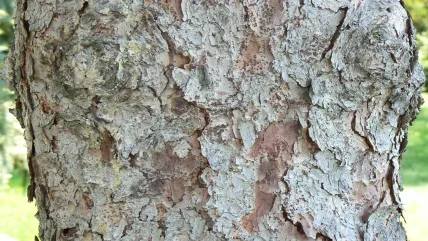
The BioComposites Centre at Bangor University has done extensive studies into sources and industrial applications of bio-phenol.
Among its research, the bark of Sitka spruce was studied – with results shared at last year's International Panel Products Symposium in Wales. The testing and conclusions of that research, undertaken by Dave Preskett and Rob Elias, are shared in this report.
Sitka spruce is the most dominant conifer species in British forestry, forming over half of the UK’s forested area. With 11.4m tonnes of softwood logged in the UK in 2018, it is estimated that up to 500,000 tonnes of Sitka spruce bark could be available. Currently, most of this is processed into low-value horticultural mulches and composts.
Reports on the material dating back to World War II gave a figure of between 11.2% (57% purity) and 37.2% (69% purity) of tannin on a dry matter basis, stating the tannin was a catechin type. But there are conflicting reports of the yield of the compounds existing in the tannin.
Research
The research undertaken by the BioComposites Centre saw Sitka spruce bark obtained from sawmiller BSW Timber’s Newbridge mill.
The bark was kiln dried at 50OC for three days then hammer milled through a 3mm sieve plate. Extraction work took place at the BioComposites Centre’s Technology Transfer Centre at Anglesey. Extraction solvents and reagents were technical grade from Fisher UK, while resin formulation and testing was carried out by Hexion at Peterlee and Finland.
Four extraction methods were employed and the resin from two of them (pilot-scale NaOH extraction and pilot-scale stilbenoids extraction) was sent to Hexion for substitution in phenol formaldehyde resins. Test plywood boards were manufactured from conditioned 1.5mm British veneers into a seven-ply 600mm x 600mm x 10.5mm thick product. The press temperature was 128OC, with different open assembly and pressing times evaluated.
Boards were tested for internal bond (IB) strength and 24hr thickness swell versus a standard control board. Tensile strength of the glue line was measured on each panel after 24hr water soak and boil tests.
The NaOH extract’s gloopy consistency caused dispensing problems in formulation by Hexion in Finland, while the cost of freight shipping was considerably higher due to the caustic character of the extract that required special packaging and handling.
Meanwhile, the pilot scale extraction provided an extract mainly composed of stilbenoids dominated by astringin with a purity of more than 80%. Shipping and freight required no special conditions. The physical properties of the solvent extract from the pilot plant performed as well as the NaOH product.
As a result, the NaOH sample was rejected and the pilot-scale organic solvent extract was formulated into a resin and its properties found comparable to a PF resin.
The storage stability test also gave a result in line with what would be expected from a standard resin. Bond strengths showed mean tensile strength (water soak – 2.14N/mm2 and boil – 1.87N/mm2) was better for the Sitka resin boards than that of the control board and mean wood failure was lower (water soak – 61% and boil – 68%).
Conclusions
The extraction and evaluation of biophenolic compounds from the bark of Sitka spruce was demonstrated to be useful as a phenol substitute. The yield and purity of the crude organic solvent extracts produced at lab and pilot scale were high and showed good reactivity with formaldehyde.
Plywood produced from the resin demonstrated acceptable board strengths showing that the resin obtained is comparable with that of a standard phenolformaldehyde resin.
Researcher Dave Preskett said more recent follow-up research work has looked at other sources of biophenol and testing these for reactivity towards formaldehyde. Successful testing is contributing towards a “library” of useful natural sources for biophenol.
“Where this technology from Sitka spruce bark has an advantage is that it does not have the hazards associated with phenol,” Mr Preskett told WBPI.
“It can be easily transported too with low hazard so in terms of safe handling and transport this new product differs considerably from those resin systems using a caustic extract of bark. It does suffer from the drawback in that it does not get around the issue of formaldehyde, which remains a big issue in the industry.
“The problem for commercialisation is the incredibly cheap prices for phenol feedstock currently enjoyed by resin manufacturers where phenol prices are pennies per kg.”
Mr Preskett said the bio-phenol could be used for demonstration applications or specified for one-off projects, but wider uptake was unlikely until mineral oil supplies became tighter and more costly.
He said the crunch time comes when supply of petroleum-based products would no longer be able meet demand – possibly far earlier in the run-up to the 2050 predicted date when oil supplies run short.
Future work should include an assessment of the levels of stilbenoids in spruce barks, examining variations caused by height, provenance, latitude and site conditions.
Also, an optimisation of the extraction process to provide a purer and more reactive extract could be explored. Other applications are also being examined for the material.






